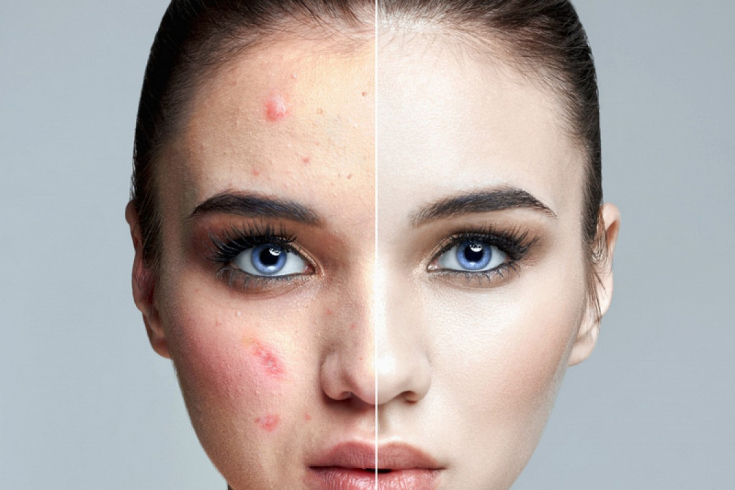Acne (or acne, acne) – one of the most common skin imperfections, which can cause psychological discomfort at any age. There are a lot of types of acne and the reasons for their appearance, but one thing unites them – mechanism of development: the sebaceous glands are clogged with sebum, dead skin cells and particles of pollution.
In the clogged glands, the growth of bacteria accelerates, the inflammatory process starts. One of the reasons for the increase in sebum production and, as a result, blockage of the glands, are hormones. Today estet-portal.com will talk in more detail about this cause of acne and methods of getting rid of hormonal acne.
- Hormonal acne: where and when do they appear
- What hormonal disorders can lead to acne
- The role of estrogen in the development of acne
- Factors that may increase the severity of hormonal acne
- How to get rid of hormonal acne
Hormonal acne: where and when do they appear
Pimples associated with hormonal changes in the body often appear in adolescence and disappear after the normalization of hormonal levels. However, this problem can also disturb an adult.

Women may develop acne periodically, for example:
- during ovulation;
- one week before the onset of menstruation;
- after the onset of menstruation.
Most often, acne caused by hormonal disorders is presented in the form of cystic acne – inflamed red bumps filled with pus and painful. But the problem can manifest itself in the form of comedones and small pimples, more like a rash.
Read more: Acne and Hormones: 16 Facts Everyone Should Know
Localization of hormonal acne:
- around the mouth (including under the nose, on the chin);
- along the jawline;
- sometimes on cheeks and forehead;
- on the shoulders, back and buttocks.
Most often, hormonal acne occurs around the mouth and along the jaw line.
Learn: Imbalance is detrimental to the skin: hormonal causes of acne

We'll look at:
- what hormones can cause acne;
- Factors that may increase the appearance of hormonal acne.
- how to get rid of hormonal acne.
What hormonal disorders can lead to acne
Hormonal acne is the result of increased production of sebum. In normal amounts, sebum (i.e. sebum) is essential for skin health and protection, however, excess of this substance provokes blockage of pores, including dead cells and impurities. In such an environment, the rapid growth of bacteria begins, to which the skin reacts with inflammation, which is accompanied by redness and pain.
Male sex hormones (androgens) – testosterone and dehydroepiandrosterone sulfate. The problem of acne is aggravated if the level of female sex hormones, especially estrogen, decreases.
Read: Acne in Bodybuilders: Causes and Treatments
Causes of high testosterone levels in women:
- The most common cause of high testosterone in women is polycystic ovary syndrome, one of the characteristic symptoms of which is the appearance of acne;
- diabetes or insulin resistance (because insulin stimulates testosterone production);
- ovulation (this phase of the menstrual cycle is characterized by an increase in testosterone levels).
Causes of elevated levels of dehydroepiandrosterone sulfate (DHEA-S)
This hormone is produced mainly in the adrenal cortex (95%), its production increases under stress, therefore constant stressful situations can provoke the appearance of hormonal acne.
The role of estrogen in the development of acne
The hormone estrogen is essential for healthy skin. First, it helps lower blood testosterone levels by increasing sex hormone-binding globulin (SHBG) levels. Secondly, this hormone plays a direct role in the beauty and health of the skin, maintaining its normal thickness, firmness and elasticity.
In women with chronically low estrogen levels, hormonal acne is common and difficult to treat.
Estrogen levels can be lowered, among other things:
- at the end of the menstrual cycle;
- in case of hypothalamic amenorrhea;
- during menopause.

Elevated progesterone as a cause of acne
Progesterone in large quantities has a pro-inflammatory effect, as a result of which acne may appear. The highest level of progesterone is observed a few days before the onset of menstruation, which is why many women develop acne during this period.
Read: Three Causes of Cystic Acne
Whether birth control pills can cause acne depends on the characteristics of the body and its response to hormones. Therefore, if you have experienced acne after starting birth control pills, it makes sense to switch to other means.
Factors that may increase the severity of hormonal acne
There are a number of factors that can worsen the condition of the skin in general and increase the appearance of hormonal acne in women. These include:
- stress (induces inflammation by promoting cortisol and DHEA-C production and suppressing estrogen production);
- high temperatures (excessive sweating contributes to clogged pores);
- ultraviolet;
- pro-inflammatory foods (dairy, sweet, rich in phytoestrogens);
- low carb diet;
- bad sleep;
- hypothyroidism.
How to get rid of hormonal acne
To get rid of hormonal acne, you must first determine the exact cause of their appearance. To do this, you need to consult a doctor (in this case, it is advisable to consult a dermatologist, gynecologist and endocrinologist), who will conduct an examination, prescribe the necessary tests and draw up a treatment plan.
Learn more: Acne in women of reproductive age. How to deal with it

In this case, it will not be possible to limit ourselves to topical agents (creams, ointments, etc.), since they are only one component of complex therapy.
As part of your treatment, your doctor may prescribe:
- topical preparations (e.g. retinoids);
- hormonal correction drugs (depending on the problem);
- special products for daily facial care;
- Cosmetological procedures for acne removal (peelings, laser treatment, etc.);
- special diet.
To get rid of hormonal acne, you must definitely consult a doctor – only a qualified specialist will be able to competently draw up a comprehensive treatment plan.








Add a comment